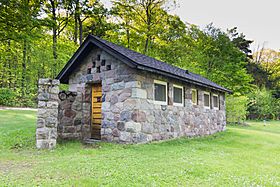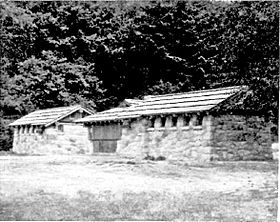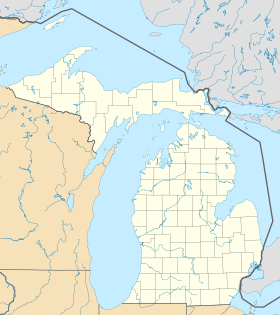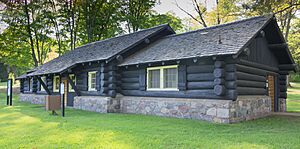Bewabic State Park facts for kids
Quick facts for kids Bewabic State Park |
|
|---|---|
|
IUCN Category III (Natural Monument)
|
|

Oldest building in the park
|
|
| Location | Crystal Falls Township Iron County, Michigan |
| Nearest city | Crystal Falls |
| Area | 315 acres (127 ha) |
| Elevation | 577 feet (176 m) |
| Designation | Michigan state park |
| Established | 1923 (state park 1966) |
| Administrator | Michigan Department of Natural Resources |
| Website | Bewabic State Park |
|
Bewabic Park
|
|

Bewabic bathhouse, c. 1938
|
|
| Built | 1923, 1935 |
| Built by | Civilian Conservation Corps |
| Architect | Abraham Anderson, Glenn Case Gregg |
| NRHP reference No. | 16000179 |
| Added to NRHP | April 19, 2016 |
Bewabic State Park is a fun place to visit in Michigan. It's a public park that covers 315 acres (about 1.3 square kilometers). You can find it on the shore of Fortune Lake, about 4 miles (6.4 km) west of Crystal Falls.
This park is special because of its history with the Civilian Conservation Corps (CCC). The CCC was a group of young men who worked on public projects during the Great Depression. Many buildings and structures they built are still used in the park today! Because of these historic buildings, Bewabic State Park was added to the National Register of Historic Places in 2016.
Contents
Park History: How it Started
The story of Bewabic Park began in 1917. A man named Herbert F. Larson worked for the Iron County Road Commission. He used a Michigan law to buy land for public parks. He especially looked for areas with old, untouched forests.
In 1919, Larson helped create the first roadside park in America. It was on Stager Lake. This park was a big success! So, Larson decided to buy more land for other parks, including the area that is now Bewabic State Park.
Creating Bewabic Park
Bewabic Park officially started in 1923. Larson bought a 120-acre farm next to Fortune Lake. This land had a beautiful forest. He turned the old farmhouse into a home for the park caretaker. He also added a swimming beach, a picnic area, a parking lot, and a campground.
Not much changed at the park until 1933. That's when workers from the Civil Works Administration (CWA) came to help.
Building with the CWA and CCC
In 1933, 170 CWA workers started improving Bewabic Park. They built a footbridge and a trail to an island in Fortune Lake. They also added a bandstand and tennis courts. For picnickers, they put in stoves and tables. They even built a large wooden picnic shelter called "The Wigwam."
After the CWA program ended, the Civilian Conservation Corps (CCC) took over. From 1935 to 1937, 108 CCC workers continued to build and improve the park.
The CCC workers followed a big plan for Bewabic Park. Local architect Abraham Anderson designed the buildings. Glenn Case Gregg from Michigan State College planned the landscaping. The workers moved the farmhouse and tore down old barns. They made the picnic area bigger.
They built a log bathhouse with changing rooms and canoe storage. They also built a stone restroom and stone drinking fountains. More benches, tables, a playground, and footpaths were added. The camping area also grew.
Becoming a State Park
In 1966, the state of Michigan bought Bewabic Park. This was part of a plan to make the state park system much larger. The next year, Michigan bought 40 more acres to make the park the size it is today.
In 1971, the bathhouse was updated. In 1975, the campground became much bigger. Even with these changes, the park still has many original buildings. These structures were built by the CWA and CCC and show a special "rustic park architecture" style.
Exploring Bewabic Park's Historic Buildings
Bewabic Park covers 315 acres (1.3 km²) along Fortune Lake and next to US 2. A stone wall, built by the CCC in 1936, runs along US 2. The park has different areas for day use, including an island. It also has three camping areas.
Northeast Day-Use Area
This area is near the Fortune Lake beach.
- Log Bathhouse: A log bathhouse built by the CCC in 1937 sits on a hill above the lake. It was designed by Abraham Anderson. It's made of dark brown logs on a stone base. It has a low roof and a central entrance. The sides used to be dressing rooms and canoe storage. They were changed into restrooms in 1970.
- Picnic Shelter: A log picnic shelter, built in 1974, is a bit lower on the hill.
- Picnic Spot: Between the bathhouse and picnic shelter, there's a circle of maple trees. Inside, you'll find a stone stove and a picnic table.
Island Fun
You can reach an island from the beach by a foot trail.
- Island Creation: This island used to be a peninsula. In 1933, CWA workers dug a canal to separate it from the main shore.
- Footbridge: A short wooden bridge crosses the canal. A trail goes around one end of the island.
- Fireplaces: The island has three fireplaces built by the CCC. Two are small and made of stone, about knee-high. The large one is made of rough, cut stones.
Southwest Day-Use Area
This area is separated from the beach by trees. It has many things to do.
- Restroom: There's a stone restroom building and a stove/fireplace. The restroom was designed by Abraham Anderson in 1936. It's made of stone with a wood shingle roof. It has special ventilation openings made by leaving out some stones.
- Tennis Courts: You can find tennis courts built by the CWA in 1934.
- Playground: There's also a small playground.
- Amphitheater: A natural dip in the ground used to hold a band shelter built by the CWA in 1934. The shelter is gone, but the area is still used as an amphitheater for performances.
Campgrounds
Bewabic Park has three camping areas: Loop A, Loop B, and Loop C.
- Loop A: This loop was built by the CCC in 1936. It has 28 campsites around the outside of the loop. The center is a grassy shared area. Thick plants separate the campsites.
- Loops B and C: These loops were built in the 1970s. Loop B has 48 campsites, and Loop C has 55. Their campsites are on both sides of the roads, and they don't have as much plant separation.
Activities and Things to Do
Bewabic State Park offers many fun activities for visitors:
- Playing tennis on the courts
- Swimming in Fortune Lake
- Fishing
- Hiking on trails
- Having picnics
- Launching boats
- Playing on playgrounds
- Cross-country skiing in winter
- Metal detecting (with permission)
Images for kids







